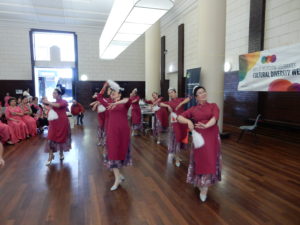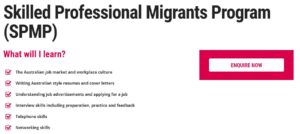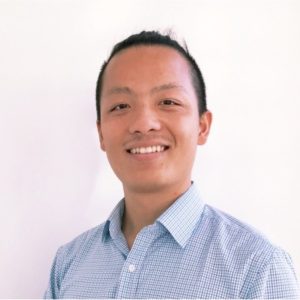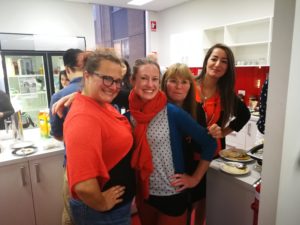News from AMES Australia
 Community fair a hot with locals
Community fair a hot with locals
The annual Community Cultural Fair held at the Drill Hall last Sunday was another great success thanks to the enthusiasm and energy of Multicultural Hub staff and volunteers.
The event featured about a cavalcade of performers including dancers from Nepal, Samoa, China, Chile, Japan and the Himalayas as well as a Bollywood troupe.
The audience of several hundred people, including from communities represented, local residents and people passing by, was also treated to performances by a Chinese choir, a Pakistani singer and the Burundi Drummers.
There were stalls offering face painting for kids, traditional fabrics and handcrafts, henna hand painting, an origami workshop, pom-pom making, Ethiopian coffee and delicious food.
The day was rounded off with a forum themed around the notion ‘There’s no such thing as a dumb question’ in which a panel of emerging community representatives answered questions about their communities, their religions and their experiences in coming to Australia.
The panel included AMES Australia International and Community Development Manager Melika Yassin Sheikh-Eldin
Event organiser Reshma Manandhar said the Fair would not be the event that it has become without the commitment of the Multicultural Hub’s volunteers.
“Our volunteers greeted visitors, supported performers, managed the sound system, encouraged stallholders and generally made everyone feel welcome,” Reshma said.
Now in its eighth year, the Community Cultural Fair has become an iconic part of Harmony Week in Melbourne.
 Mentoring program helping skilled migrants into work
Mentoring program helping skilled migrants into work
A professional mentoring program is succeeding in getting newly arrived skilled migrants into jobs that fit their qualifications and experience while also helping to harness the skills and cultural knowledge migrants bring with them, according to new research.
A study of the effectiveness of the Skilled Professional Migrants Program (SPMP) and its mentoring component – which aims to bridge the cultural divide faced by some migrants relaunching their careers in Australia – found that a large number of professional migrants faced considerable challenges in finding work in their fields.
But the study also found that after completing the SPMP, around 80 per cent of students had found work and 61 per cent were in professional jobs.
Before enrolling in the SPMP program, less than 35 per cent of participants had worked in Australia. Those who had worked were mostly in low skilled or non-professional roles.
The study recommends increased investment in programs like the SPMP to improve migrant inclusion in the workforce as well as engaging more employers and stakeholders with professional mentoring program to help more skilled migrants to find work in their professions.
It also recommends replicating some of the features of the SPMP to other groups newly arrived in Australia such as refugees.
The SPMP program, operated by AMES Australia, introduces professional migrants to Australian workplace culture and job seeking techniques. Participants receive advice about professional interviews as well as insights into Australian workplace culture.
The study titled ‘A report on professional mentoring in AMES Australia’s Skilled Professional Migrant Program (SPMP), found barriers to work included: unfamiliarity with recruitment practices; a lack of professional networks and difficulty growing them; little knowledge of Australian workplace culture; and, difficulties having qualifications recognised.
The research was based on interviews exploring the job seeking experiences of 379 people who had completed the SPMP program over four years between 2013 and 2016. It also included a focus group of 12 independent mentor-mentee relationships.
It canvased participants from 40 countries – the majority from China, India, Sri Lanka, Iran and South America. The largest groups of professionals were engineers, IT specialists, accountants, scientists and business managers.
AMES Australia CEO Cath Scarth said the research showed small interventions could make a big difference in helping newly arrived professionals into work in Australia.
“Attracting people with professional skills and qualifications is a significant objective of Australia’s immigration program. But in many cases these skills are going unused and we are missing out on potentially productive people who can bring new perspectives and unique problem solving skills,” Ms Scarth said.
“We are seeing many of these professional migrants accepting jobs outside their skill sets or in roles well below their actual capacities,” she said.
“This research shows these kinds of programs are effective in giving professional migrants and insight into and some experience of what it takes to get a job in Australia,” Ms Scarth said.
 Construction engineer Anthony Wang from China migrated to Australia in 2018. After an initial struggle to find work in his field, he joined the SPMP to learn more about the local job market and application process.
Construction engineer Anthony Wang from China migrated to Australia in 2018. After an initial struggle to find work in his field, he joined the SPMP to learn more about the local job market and application process.
Two months after completing the program, he secured a job as a project coordinator working for a small building company.
Anthony said being matched with a mentor who had over 25 years of experience in his industry was very helpful.
“My mentor helped me to understand the recruitment process and the purpose of the process,” Anthony said.
“I was able to attend interviews with a clear idea of what message to get across to the recruiter,” he said.
Harmony Day celebration at Dallas
Recently staff AMES Australia from the Humanitarian Settlement Program (HSP) and Status Resolution Support Services (SRSS) at Dallas celebrated Harmony Day with an afternoon of international food, fun activities and learning about other cultures from colleagues.
Harmony Day is an annual event that celebrates multiculturalism and the successful integration of migrants into our communities. It’s about inclusiveness, respect and a sense of belonging for everyone.

The team at Dallas decorated the office orange and dressed in orange to show their support for cultural diversity and an inclusive Australia, as orange is the colour chosen to represent Harmony Day. Traditionally, orange signifies open communication, freedom of ideas and encouragement of mutual respect.
Staff joined together for a multicultural lunch where staff members prepared dishes from their home countries to share with the rest of the team.
Marybeth Yarosh, Team Leader, Humanitarian Settlement Program said: “There was a fantastic spread of dishes from around the world. It was a great opportunity to try new foods and learn more about other cultures.”
Leza Makaeoo, Case Manager HSP said “I really enjoyed the Harmony Day celebrations. During the lunch I couldn’t help but think about a quote from Melanie Koulouris ‘Harmony is a beautiful balance between mind, body, and soul measured in tender peaceful moments.'”
Staff members got involved in creating a Harmony Hand Tree, where everyone decorated a hand with something that represented them and their heritage or how they feel about harmony.
AMES client gets a job
AMES Australia client and Syrian refugee “Tom” gained permanent employment soon after arriving in Australia thanks to the hard work of AMES Australia staff at Dallas.
Tom arrived in Australia in October 2017 with his wife and children. Tom has many years’ experience working as a Project Manager in the construction industry.
Due to the threat of ISIS, Tom and his family were forced to flee their home country. Once Tom found out his family’s humanitarian visa had been approved, he felt a huge sense of relief, as he knew his family would soon be safe. Tom started researching job opportunities and preparing his resume. He said “I wanted to try and get a job as soon as I could, so I could provide for my family and give them a good life here.”
Tom and his family were referred to a Case Manager at Dallas, through the Humanitarian Settlement Program. As well as helping the family in their settlement journey, the Case Manager provided Tom with advice about getting jobs and referred him for interviews. Tom said “My Case Manager has been so helpful, he has helped us with everything including helping me to find a job. Thank you.”
Tom attended an interview for a casual labourer job on a construction site and was asked to start work that day! Within a few weeks, Tom had shown his excellent technical and leadership skills and was given more responsibility.
The manager also became aware that Tom had experience using a high-performance project management software.
“Once the boss heard I had experience using that software, he asked me to come into the office and show him I could use it without any help,” Tom said.
Tom is now working in the office at the construction site focussing more on project management and he is hoping to get a pay increase soon.
Tom is delighted he has been able to progress to a new job so quickly. He hopes that his wife will able to find a job in her field in the future or do some study that will help her find a job here. But for now, she is focusing on taking care of their children.
Laurie Nowell
AMES Australia Senior Journalist












